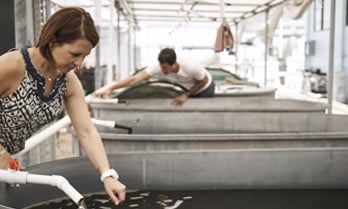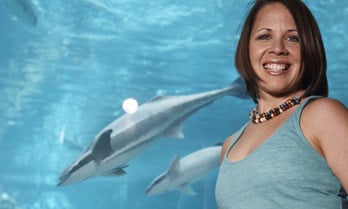Dr Shari Breen, astronomer, CSIRO, Sydney
15 September 2015
The short lives of hard-living, fast burning, high mass stars
We are made of star stuff. The nitrogen in our DNA, the calcium in our teeth and the iron in our blood were all made in high mass stars that burnt briefly and brightly before exploding.
Dr Shari Breen is using ‘The Dish’ at Parkes and a network of international telescopes to understand the life cycle and evolution of these stars. For her the 1,000 tonne Parkes radio telescope is an old friend that creaks and grumbles as she guides it across the sky, hunting for high mass stars.
She will use her L’Oréal-UNESCO For Women in Science Fellowship to develop her use of masers (laser-like beams of intense radio waves) to investigate these stars.
Qualifications
| 2010 | PhD (astronomy), The University of Tasmania, Hobart |
| 2005 | Bachelor of Science (Honours), The University of Tasmania, Hobart |
Career highlights, awards, fellowships, grants
| 2015 | Two week study tour of Chile, including presentation at an international conference and a week working at the University of Chile, Chile |
| 2013–2015 | ARC Discovery Early Career Researcher Award (DECRA), Tracing the evolution of high mass stars: combining maser evolutionary timelines with chemical clocks |
| 2014 | Invited to work with colleagues at National Radio Astronomy Observatory and Boston University, Boston, USA |
| 2014 | Study tour, invited presentation and collaboration with University of Manchester, UK |
| 2014 | Invited presentation, National Astronomical Observatory of Japan, Tokyo, Japan |
| 2014 | Study tour and invited presentation National Astronomical Observatory of Japan and Yamaguchi University, Japan |
| 2013 | Invited review presentation, Australia Telescope Compact Array’s 25th Birthday Conference, Narrabri |
| 2013 | Extended study trip to the University of Manchester, Manchester, UK |
| 2010 | Bolton Fellowship at CSIRO Astronomy and Space Science |
| 2009 | Best Galactic Astronomy Poster, Australia Telescope National Facility Synthesis School, Narrabri |
| 2007–2010 | CSIRO Postgraduate Scholarship |
| 2007–2013 | Tasmanian Graduate Research Scholarship |
| 2005–2006 | Australia Telescope National Facility Summer Vacation Scholarship |
Top five publications
Breen SL, Ellingsen SP, Caswell JL, Lewis BE (2010) 12.2-GHz methanol masers towards 1.2-mm dust clumps: quantifying high mass star formation evolutionary schemes, Monthly Notices of the Royal Astronomical Society 401: 2219–2244. (Impact factor 5.521, 69 citations)
Walsh AJ, Breen SL, Britton T, Brooks KJ, Burton MG, Cunningham MR, Green JA, Harvey-Smith, L, Hindson L, Hoare MG, Indermuehle B, Jones PA, Lo N, Longmore SN, Lowe V, Phillips CJ, Purcell CR, Thompson MA, Urquhart JS, Voronkov MA, White GL, Whiting MT (2011) The H2O Southern Galactic Plane Survey (HOPS)–I. Techniques and H2O maser data, Monthly Notices of the Royal Astronomical Society 416: 1764–1821. (Impact factor 5.521, 59 citations)
Breen SL, Caswell JL, Ellingsen SP, Phillips CJ (2010) Water masers accompanying OH and methanol masers in star formation regions, Monthly Notices of the Royal Astronomical Society 406: 1487–1532. (Impacts factor 5.521, 54 citations)
Breen SL, Ellingsen SP, Caswell JL, Green JA, Voronkov MA, Fuller GA, Quinn LJ, Avison A (2011) Statistical properties of 12.2 GHz methanol masers associated with a complete sample of 6.7 GHz methanol masers,Astrophysical Journal 733: 80–97. (Impact factor 6.733, 29 citations)
Breen SL, Ellingsen SP, Contreras Y, Green JA, Caswell JL, Stevens JB, Dawson JR, Voronkov MA (2013) Confirmation of the exclusive association between 6.7-GHz methanol masers and high mass star formation regions, Monthly Notices of the Royal Astronomical Society 435: 524. (Impact factor 5.521, 22 citations)




